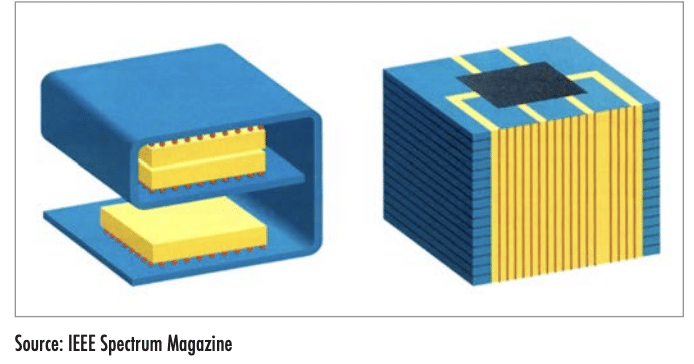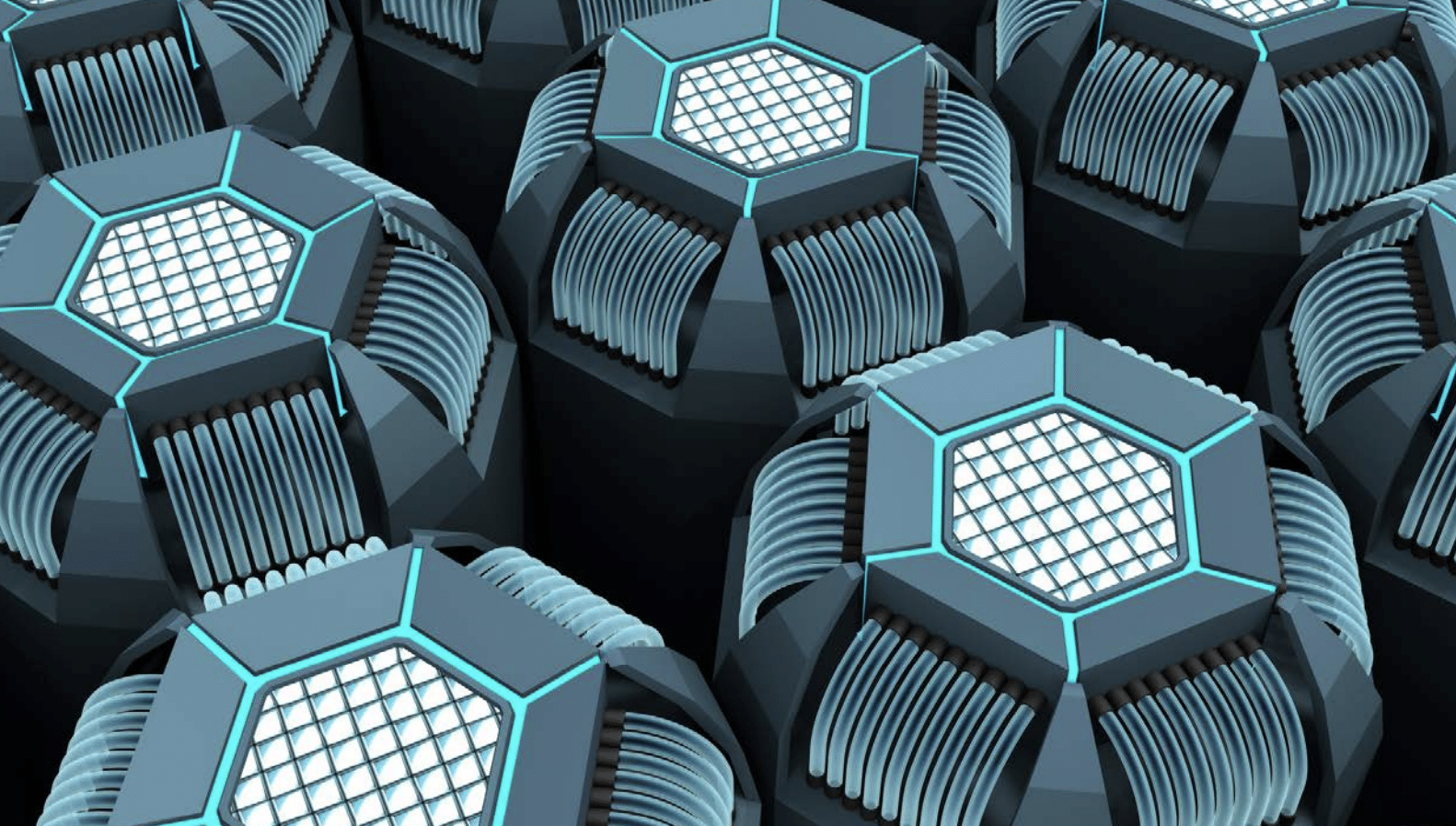THE FUTURE OF SHIELDING
The future is not all that far off. With more electronic devices that are getting smaller, more portable and with continuing faster speeds, EMI or RF issues will continue to increase. There will be more integrated system-onchips (SoCs) where several functions will all be in one device that will need to be electromagnetically isolated. As an example, a GPS receiver working at -100 to –120 dBm will have to co-exist with a transmitter working @ 0 to +40 dBm. Automotive collision avoidance systems work at about 75 GHz and “regular” gasketing begins to degrade above 18 GHz making them ineffective at these frequencies due to skin effects and electromigration.
Here are some excerpts of quotes from David Leinwand of Hamamatsu taken from Tech Briefs, “Visions of Tomorrow”, December 2001 issue published by NASA as “food for thought”.
“…a new wireless local-area network may have to operate at 60 GHz.”; “…heterojunction bipolar transistors (HBTs), a technology that is now yielding large-scale integrated (LSI) circuits packing 1000 to 10,000 transistors on a chip and operating at over 65 GHz.”; “ …100 Gb/s links could be in production as soon as 2010”. RSFQ (Rapid Single Flux Quantum) logic is real today with speeds of 10 GHz to 800 GHz! The future is not all that far away with the very next generation logic devices having edge rates of 10-25 picoseconds (f = 40 – 100 GHz). Carbon tubes and Nanotechnology is already here and available along with RSFQ logic. These are molecular size devices. A nanocomputer could fit in a box 1/100th of a cubic micron with gigabytes of storage in a box about a micron wide (the size of a bacterium!). “Integrated circuits will be designed in three dimensions. Data will be sent by photons…Quantum computing will replace conventional computers…”

So, where does shielding go from here? At the higher frequencies, surface conductivity becomes a critical parameter. Skin effect basically means that currents will tend to crowd into the upper most layers of a conductor. So, as more current gets crowded into less thickness, the current density increases. This produces an increased voltage drop and hence, the potential for more radiation or leakage. The surface conductivity of the finishing layer or gasket material becomes critical. This is because some of the protective finishes such as zinc chromate are composed of conductive particles in a binder material. Of course, as frequencies go higher, wavelengths become shorter, openings become more significant leading to increase potential for leakage.
To demonstrate the magnitude of this EMI design criteria about keeping holes and slots small, let’s go through a calculation. For a frequency of 100 GHz, the corresponding wavelength is 0.12 inches. Typically, holes should be no larger than 1/20th to 1/50th of a wavelength, and if anything, they may need to be smaller, so this calculates to 3 to 6 mil hole or aperture. So, at some point an alternative to enclosure shielding needs to be explored since it is impractical to completely enclose the source as any practical device will have holes and slots for antennas, cables, power cords, etc. It is becoming difficult to pursue the standard shielding approach of “containing” the noise.
Most of today’s shielding theory is based upon far-field conditions and not near field conditions. This is especially critical in dealing with board level shields and the smaller size of today’s devices, as different calculation methods need to be used for better results. The E or electric component and the H or magnetic field components must be analyzed separately. Current distribution and distributed parasitic impedances become involved. Also, skin depth effects can possibly be taken advantage of by having a two shielding layers separated by a low dielectric material and possibly obtain very high levels of shielding due to having “multiple layers.”
With increasing use of “thin” shields like electrodeposition or vacuum metallization especially with plastic enclosures, the second boundary becomes important. When using thick metal shields/enclosures, re-reflection or multiple reflection effects could be ignored, but with thin shields, the absorption loss is negligible and hence passes through the thin shield with minimal loss. This effect is prevalent with magnetic fields. Electric fields are not affected that much since most of its losses comes from reflection at the first boundary.
Another issue with higher frequencies is resonance effect. Its coupling is a consequence of self-resonance of various structures such as reactively terminated transmission lines, slots in the PCB, slots between the PCB and metallic enclosure, etc. These structures behave as cavity resonators. A 2 inch by ½ inch enclosure resonates at a first order mode of around 12 GHz. Even weak coupling at these extremely high frequencies can induce strong oscillations than can then couple to any other point in the enclosure. To reduce this phenomenon, the “Q-factor” of the cavity must be lowered by introducing losses. So, in the future, shielding could become more of a multilevel concept. Board level shields will handle the “lower” frequencies as usual through it acting as a shielded enclosure, but then an inside layer of absorber coating will handle the much higher frequency components by reducing resonance conditions. Absorber materials are a viable option for handling these higher frequency issues. Absorbers work most efficiently at these higher frequencies (>1 GHz). Absorbers reduce radiation or “shield” by literally absorbing the energy and converting it to heat. This brings up another advantage in using absorber material in that since it converts the electromagnetic energy, it does not have to be “grounded.” As long as the absorber material intercepts or is in the field path, then it will reduce the electromagnetic energy of the field.
Conductive plastics are re-emerging as a potential option to provide shielding. In the past, conductive particles (i.e. carbon, steel, etc.) were added to the plastic material to give it conductivity. However, this was without its own shortcomings in that it did not provide very effective shielding. Most conductive plastics only produced about 20-40 dB of shielding. Higher shielding levels were possible (i.e. 60-80 dB), but at the expense of harming the mechanical properties of the initial base plastic material since more conductive particles needed to be added. This also increased the weight and cost of the enclosure. Another equally important factor is that the surface of this conductive plastic was non-conductive since the conductive particles tended to settle away from the external surface. So, it is possible to have a plastic enclosure which has shielding qualities, but with major compromises in terms of processability, performance, and/or cost.
This finally leads us to today with the increasing exploration of intrinsic conductive polymers. This yields a true “conductive plastic”. The main advantage in using inherently conductive polymers (ICPs) is that the user obtains the conductivity of metal such as copper, but at the fraction of the weight and with less sacrifice of losing the characteristic advantages of the main plastic material. Also, no additional processes or steps would be required to expose a conductive surface saving additional manufacturing process time and cost. Yet another advantage of conductive polymers is that they are more environmentally friendly which is especially important in today’s trend.
Most shields are quantified with high levels of conductivity, but sometimes this kind of shield is not necessarily the ideal solution. It is also impossible with this kind of shield to perform frequency selective shielding. A shield where chirality, which means “handedness”, has been added is called chirashield. The benefits are reduced weight for a given attenuation and, as mentioned earlier, frequency selectivity. Chirality is a geometrical concept. It is also described as handedness (i.e. left-handedness and right-handedness elements). Chirality is based upon molecules existing in two asymmetrical mirror image forms having a left-handed or right-handed structure. The structures resolve the electromagnetic field into two circularly polarized fields of opposite polarization directions and different phase velocities, so combining the structure or shield which have this relationship between their “handedness” yields an attenuation much like optical light passing (remember that light is an electromagnetic wave too!!) through polarized lenses.
How about shielding “on demand” where the material can change depending on the applied stimuli (e.g. electric or magnetic). The future of shielding is not all that far off. In fact, it is here now!





